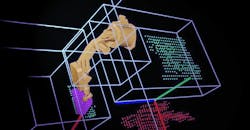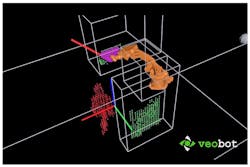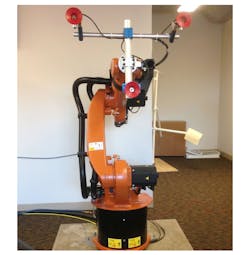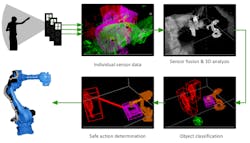Robo-Vision! Turning Robots into Cobots
If you have decided to join the robot revolution, you’re not alone. Robots and in particular, collaborative robots (cobots), are set to dominate the industrial-automation and motion-control markets. However, engineers may be hesitant to invest into a new robotic system.
Industrial robots have been the dominant technology for decades, and companies may choose to maintain their legacy equipment rather than upgrading to a cobot. Veo Robotics looks to help ease the decision-making struggle by working on machine-vision technology that will turn any robot into a cobot.
The advanced vision system developed by Veo Robotics can track humans and objects in a defined space. This causes the robot to slow down or stop when needed, creating a safe zone for human workers.
Lately, market reports show an increased interest in cobots. BIS Research reports that from 2015 to 2021, the collaborative-robot market is expected to grow to approximately $2 billion and 150,000 units.
Cobots are typically smaller, move slower, are equipped with more sensors, and built-in safety measures to make them suitable for close-to-human workspaces. To compare, Fanuc’s industrial robotic arm has a maximum payload of 2,300 kg, Kuka has one of 1,000 kg, and Motoman’s and ABB’s arms have a maximum payload of 800 kg. According to Cobotsguide.com’s comparison chart of currently available cobots, they have an average payload of only 5.8 kg and weight of 68.5 kg.
But what cobots lack in payload they make up for in safety and accuracy. Cobots have inherent safety features such as force feedback, vision sensors, LiDAR, and motion-detection sensors to make them safe to operate around human workers. They can replace tasks that require accurate and repetitive motion such as pick-and-place items or sorting.
The Kuka robot has been fitted with the Veo Robotics logic system to help control the robot for safe operations.
Veo Robotics is working on a robot that provides any robot with spatial awareness of objects and obstacles within its reach. This includes people, other equipment, and even debris. The “human aware” system has recently attracted $12 million in funding from backers Google Ventures and Next47, a venture capital firm created by Siemens. Veo Robotics system uses a set of four depth-sensing cameras that are located around the robot’s workspace to give it complete visual coverage of the area. From there, engineers can mark objects and workers in the surrounding environment.
The images highlight how the robot views its surrounding space once fitted with the Veo Robotics advanced vision system.
The logic sits on top of the robot’s controller, so adjusting the dimensions of girders and human standing locations is not required. The robot performs its typical operation, but once a human or object enters the marked danger zone, it can slow down or stop altogether. To ensure complete safety, any camera malfunction or obstruction of its field of view makes the robot comes to a full stop until the problem is corrected.
CEO Patrick Sobalvarro has a long history with cobots. He was the former president of Rethink Robotics. The decision to invest in advanced vision systems for industrial robots came from the fact some industrial companies were more interested in upgrading their large industrial robots rather than investing in smaller cobots and potentially losing efficiency.
“We can override the controls on that robot and allow it to behave in a responsive way to the presence of a human. That’s different from what happened in the previous generation of collaborative robotics,” says Sobalvarro. By creating industrial robots that have the safety of cobots, you gain the best of both worlds: Robots with a large payload that can operate safely around humans.



